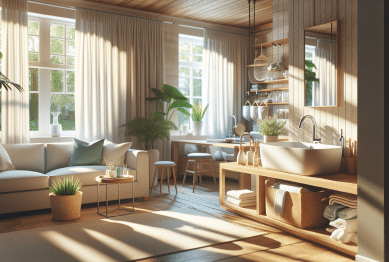Building your first home is an exciting milestone, but it can also be overwhelming, especially when it comes to managing costs. The dream of owning a home is shared by many, but for first-time builders, keeping expenses under control while still creating a comfortable, functional living space is crucial. We’ll explore practical tips and strategies to help you Building Your First Home Without Breaking the Bank, from budgeting and financing to choosing cost-effective materials and working with the right professionals.

Why Budgeting is Key in Home Construction: Building Your First Home Without Breaking the Bank
Before breaking ground, creating a solid budget is the first and most important step in building your first home. Without a clear financial plan, costs can quickly spiral out of control, leading to stress and financial strain. By setting a realistic budget and sticking to it, you can avoid overspending and ensure that your home-building project remains on track.
Steps to Create a Construction Budget
-
Establish Your Maximum Budget: Start by determining how much you can afford to spend, considering both your savings and available financing options. Make sure to factor in the cost of the land, permits, design plans, and unexpected expenses.
-
Account for Hidden Costs: Hidden costs, such as land clearing, utility connections, and landscaping, can quickly add up. Be sure to include these in your budget to avoid surprises later on.
-
Get Multiple Estimates: Seek out multiple bids from contractors and suppliers to ensure you’re getting the best price for materials and labor.
-
Set Aside Contingency Funds: Set aside at least 10% of your total budget for unexpected costs. This will provide a financial cushion in case things don’t go according to plan.
For more on construction budgeting, see The Balance’s Guide to Creating a Home Construction Budget.
Choosing the Right Financing Options: Building Your First Home Without Breaking the Bank
Financing your new home is one of the most important aspects of the building process. Depending on your financial situation, there are several financing options available for first-time homebuilders, each with its own pros and cons. Choosing the right option can help you manage your costs and avoid financial strain during construction.
Popular Financing Options
-
Construction Loans: Construction loans are short-term loans specifically designed to finance the construction of a new home. These loans typically offer lower interest rates but require detailed plans and cost estimates. Upon completion, the loan is converted into a traditional mortgage.
-
Home Equity Loan or Line of Credit (HELOC): If you already own a home, you may be able to use a home equity loan or HELOC to finance the construction of your new home. These loans typically offer favorable interest rates but require you to put up your current home as collateral.
-
FHA Loans: If you qualify, an FHA loan can help reduce the upfront costs of purchasing land or building a home. These loans have lower down payment requirements, making them an excellent option for first-time builders with limited savings.
-
Personal Loans: If you have good credit and prefer to avoid using your home as collateral, a personal loan can be used to cover construction costs. However, interest rates on personal loans may be higher compared to other options.
For more on financing your home build, check out NerdWallet’s Guide to Construction Loans.
Choosing Cost-Effective Materials
The materials you choose for your home can significantly impact your overall construction costs. While you don’t want to compromise on quality, there are several ways to save money by selecting cost-effective materials without sacrificing durability or aesthetics.
Tips for Saving on Materials
-
Consider Prefabricated Components: Prefabricated walls, roofs, and flooring can be much more affordable than custom-built options. These materials are built off-site and delivered to your location, which can save time and money.
-
Opt for Economical Finishes: High-end finishes such as marble countertops or imported flooring can quickly drive up costs. Instead, consider alternative materials like quartz countertops, laminate flooring, or engineered wood, which offer similar aesthetics at a fraction of the price.
-
Shop for Discounted Materials: Many building supply stores offer discounts on materials that are overstocked or discontinued. Look for sales, clearance events, and bulk buying options to cut costs.
-
Buy in Bulk: Purchasing materials in bulk can save you money, especially for items like insulation, paint, and lumber. Negotiate with suppliers to see if they offer bulk pricing discounts.
For more on choosing cost-effective building materials, check out The Spruce’s Guide to Budget-Friendly Building Materials.
Choosing the Right Contractors
Hiring the right contractors is essential to staying within budget and ensuring your home is built to your specifications. Selecting experienced professionals can help you avoid costly mistakes and delays. Here are some tips for finding and hiring the right contractors for your project:
-
Get Multiple Quotes: Always get at least three quotes from different contractors to ensure you are getting a fair price. Compare the quality of their work, their timeline, and their reputation before making a decision.
-
Check References and Reviews: Always check references, read online reviews, and ask for examples of previous work to ensure the contractor has a proven track record.
-
Negotiate: Don’t be afraid to negotiate with contractors to stay within your budget. Many contractors are willing to work with you to meet your financial constraints.
For more on hiring contractors, see HomeAdvisor’s Guide to Hiring Contractors.
DIY and Time-Saving Strategies
While hiring professionals is essential for many aspects of home construction, there are certain tasks you can tackle yourself to save money. Consider these DIY strategies to keep costs down:
-
Landscaping: Planting trees, shrubs, and flowers can be a fun and cost-effective way to improve the appearance of your property without hiring a professional landscaper.
-
Painting and Interior Finishes: If you have the time and skill, consider doing some of the painting, drywalling, or other interior finishing yourself.
-
Repurposing and Recycling: Reuse materials from other sources, like reclaimed wood or salvaged windows, to add character to your home while cutting down on material costs.
For more DIY construction tips, check out This Old House’s Budget-Friendly Home Improvement Tips.
Conclusion: Building Your Dream Home on a Budget
Building your first home doesn’t have to break the bank. By creating a solid budget, choosing cost-effective materials, financing smartly, and hiring the right professionals, you can build a beautiful, functional home without overspending. With the right planning and strategic decision-making, your dream home can become a reality, and you’ll be able to enjoy the rewards for years to come.
References:
-
NerdWallet. (2021). The Complete Guide to Construction Loans. Retrieved from https://www.nerdwallet.com/best/mortgages/construction-loans
-
HomeAdvisor. (2021). How to Hire a Contractor. Retrieved from https://www.homeadvisor.com/r/hiring-contractor-guide/
-
The Spruce. (2021). Affordable Building Materials for Budget-Friendly Homes. Retrieved from https://www.thespruce.com/affordable-building-materials-1822361









